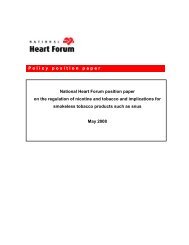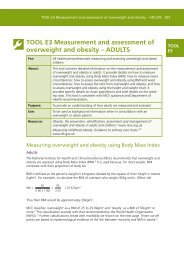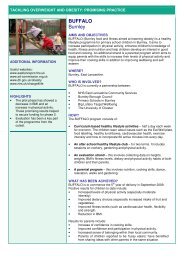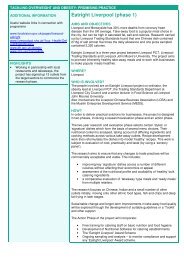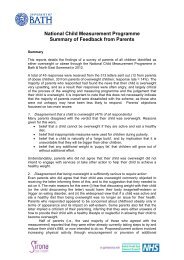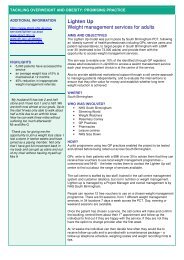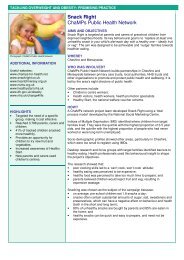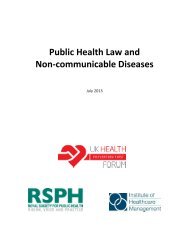The Challenge of Non-Communicable Diseases and Road Traffic ...
The Challenge of Non-Communicable Diseases and Road Traffic ...
The Challenge of Non-Communicable Diseases and Road Traffic ...
You also want an ePaper? Increase the reach of your titles
YUMPU automatically turns print PDFs into web optimized ePapers that Google loves.
54 <strong>The</strong> <strong>Challenge</strong> <strong>of</strong> <strong>Non</strong>-communicable <strong>Diseases</strong> <strong>and</strong> <strong>Road</strong> <strong>Traffic</strong> Injuries in Sub-Saharan Africa<br />
improvements in quality <strong>and</strong> quantity <strong>of</strong> care for<br />
maternal <strong>and</strong> child health, <strong>and</strong> impact evaluations<br />
are underway in many other countries. RBF is increasingly<br />
being adopted in SSA; currently there are<br />
three countries with nationwide programs <strong>and</strong> 14<br />
countries with ongoing pilots [378].<br />
Existing health resources could be used much<br />
more efficiently. <strong>The</strong> WHO estimates that 20-40<br />
percent <strong>of</strong> resources spent on health are wasted, for<br />
example through medical errors, waste, <strong>and</strong> corruption.<br />
Reducing unnecessary expenditure on, <strong>and</strong> inappropriate<br />
use <strong>of</strong>, medicines could save countries<br />
up to 5 percent <strong>of</strong> their health expenditure [371].<br />
Replacing fee-for-service payments by capitation<br />
payments at the primary-care level can reduce incentives<br />
for over-servicing. A significant step could<br />
be to link allocative efficiency <strong>and</strong> spending decisions<br />
with the practice <strong>of</strong> care. Evidence-informed<br />
clinical guidelines, together with quality st<strong>and</strong>ards<br />
<strong>and</strong> measurable indicators derived from them, can<br />
be powerful tools to underpin pay-for-performance<br />
schemes, hold providers accountable, <strong>and</strong> drive<br />
more efficient <strong>and</strong> equitable use <strong>of</strong> technologies.<br />
Also, as the Public Private Partnership (PPP) <strong>of</strong><br />
the Queen ‘Mamohato Memorial Hospital <strong>and</strong> Clinics<br />
in Lesotho has shown, health PPPs are becoming<br />
more popular <strong>and</strong> could be structured to address<br />
NCDs effectively along the medical care continuum<br />
<strong>and</strong>, in a relatively short period <strong>of</strong> time, transform<br />
the quality <strong>of</strong> care being provided to its population<br />
[379-380]. <strong>The</strong>re are four key factors driving governments<br />
to use the PPP model: (1) desire to improve<br />
operation <strong>of</strong> public health services <strong>and</strong> facilities <strong>and</strong><br />
to exp<strong>and</strong> access to higher quality <strong>of</strong> services; (2)<br />
opportunity to leverage private investment for the<br />
benefit <strong>of</strong> public services; (3) desire to formalize arrangements<br />
with non-pr<strong>of</strong>it partners who deliver<br />
an important share <strong>of</strong> public services; <strong>and</strong> (4) more<br />
potential partners for governments as private health<br />
care sector matures [381].<br />
Medicines, Vaccines, <strong>and</strong> Technologies<br />
Drug costs make up a substantial part <strong>of</strong> the direct<br />
costs <strong>of</strong> programs for chronic diseases [349]. Up to<br />
90 percent <strong>of</strong> the population in LMIC buy medicines<br />
through out-<strong>of</strong>-pocket payments [382]. In one study<br />
<strong>of</strong> the affordability <strong>of</strong> medicines in LMIC, purchasing<br />
some common medicines for the treatment <strong>of</strong><br />
NCDs would impoverish a large proportion (up<br />
to 86 percent) <strong>of</strong> the populations <strong>of</strong> many African<br />
countries [383].<br />
Access is inadequate even for many items on the<br />
list <strong>of</strong> essential medicines in most LMIC [382, 384-<br />
385]. Prices vary widely <strong>and</strong> are comparatively high<br />
in developing countries, with affordability deteriorated<br />
as a result <strong>of</strong> the global economic crisis [386].<br />
Availability may be worse for medicines for chronic<br />
diseases than for acute disease [387]. Figure 17<br />
presents results for WHO African Region countries<br />
to a WHO survey on the availability <strong>of</strong> NCD drugs<br />
in the public health system, although whether these<br />
are always physically available or require co-payment<br />
is not clear [64].<br />
FIGURE 17: Availability <strong>of</strong> NCD Medicines in the<br />
Public Health System in SSA<br />
Proportion <strong>of</strong> SSA countries stating availability <strong>of</strong> NCD<br />
medicines in public health system (n-47)<br />
100%<br />
90%<br />
80%<br />
70%<br />
60%<br />
50%<br />
40%<br />
30%<br />
20%<br />
10%<br />
0%<br />
Nicotine patches or gums<br />
Statins<br />
Source: Authors from [496]<br />
Tamoxifen<br />
Oral morphine<br />
ipratropium bromide<br />
Steroid inhalers<br />
CC blockers<br />
ACE inhibitors<br />
Metformin<br />
Insulin<br />
Beta blockers<br />
Glibenclamide<br />
Hydrocortisone injections<br />
Thiazide diuretics<br />
Prednisolone tabs<br />
Aspirin (100mg)<br />
Salbutamol<br />
Under-funding, poor planning, <strong>and</strong> inefficient<br />
procurement, supply, storage, <strong>and</strong> distribution<br />
systems within the public sector may exacerbate<br />
the problem, leading patients to the private sector<br />
where prices for generic medicines can be two- to<br />
three-fold higher than in the public sector, <strong>and</strong> expensive<br />
br<strong>and</strong>ed products may predominate [349,<br />
371]. Weak systems may be exacerbated in countries<br />
where the involvement <strong>of</strong> multiple donor agencies<br />
operating without any coordination can contribute



